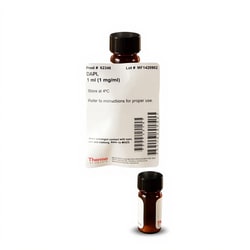Learn More
Invitrogen™ DAPI and Hoechst Nucleic Acid Stains
Descripción
DAPI is a fluorescent dye commonly used in molecular biology and cell biology research. DAPI is known for its ability to bind to DNA, specifically to the minor groove of double-stranded DNA. This dye emits blue fluorescence when excited by ultraviolet light, allowing researchers to visualize and stain DNA in various biological samples.
Hoechst dyes are DNA-specific fluorescent stains that bind to the minor groove of double-stranded DNA. They emit blue fluorescence when excited by ultraviolet light. These dyes are widely used for staining DNA in various biological samples.
Características destacadas:
Detección de núcleos: se une específica y cuantitativamente al ADN para facilitar la detección específica de núcleos y el contenido de ADN en imágenes de fluorescencia
Fluorescente: produce un producto fluorescente azul que permite la medición con microscopios y sistemas de captura de imágenes de fluorescencia (excitación a 341 nm, emisión a 452 nm)
Células fijas: especialmente para usar con células fijas en lugar de muestras de células vivas
La contratinción compatible: proporciona una contratinción efectiva junto con fluoresceína y otras sondas fluorescentes, como los flúores Thermo Scientific DyLight
Recomendada para:
Análisis de ADN en solución; diagnóstico de infección micoplasmática de cultivos celulares; medición del contenido nuclear y clasificación de cromosomas en citometría de flujo; evaluación de la apoptosis; detección de núcleos y ADN organular en procedimientos de hibridación inmunofluorescente e in situ; sustitución del bromuro de etidio para la tinción de ADN en gel de agarosa; contratinción de núcleos en métodos histoquímicos cuando se han utilizado anticuerpos fluorescentes rojos para detectar objetivos específicos; los informes también indican que DAPI se unirá a polifosfatos y otros polianiones, sulfato de dextrano y SDS.

Especificaciones
Especificaciones
| Color | Azul |
| Concentración | 1 mg/mL |
| Contenido y almacenamiento | Almacenar la solución DAPI (1 mg/ml) entre 2 y 8 °C y proteger de la luz. |
| Intervalo de longitud de onda de excitación | 360 nm |
| Tipo de colorante | Impenetrable en células |
| Para utilizar con (aplicación) | Adquisición de imágenes de células |
| Para utilizar con (equipo) | Microscopio de fluorescencia, instrumento de alto contenido |
| Cantidad | 1 ml |
| Método de detección | Fluorescente |
| Emisión | 460 nm |
| Mostrar más |
Para uso exclusivo en investigación. No apto para uso en procedimientos diagnósticos.
Proporcione sus comentarios sobre el contenido del producto rellenando el siguiente formulario.
